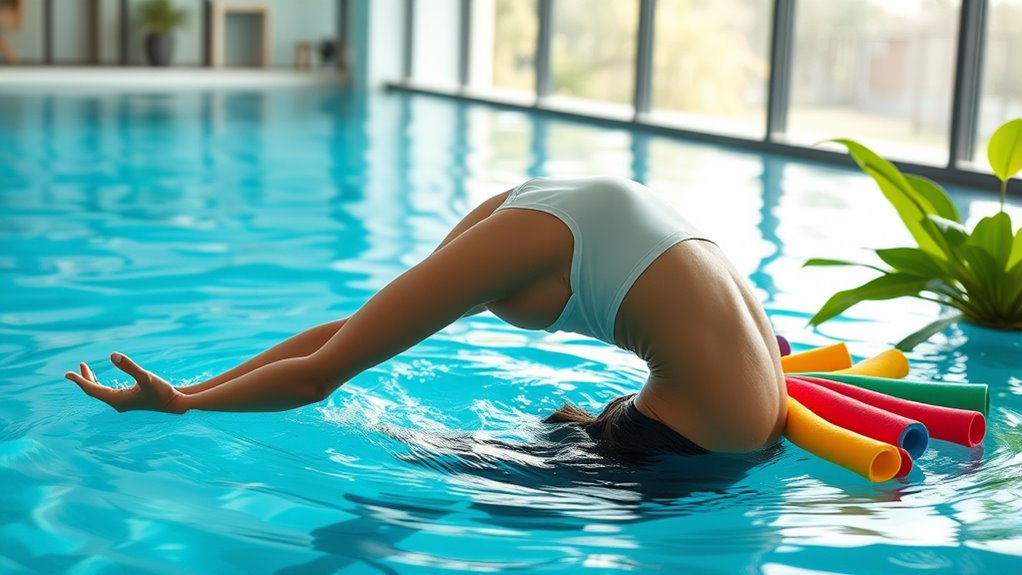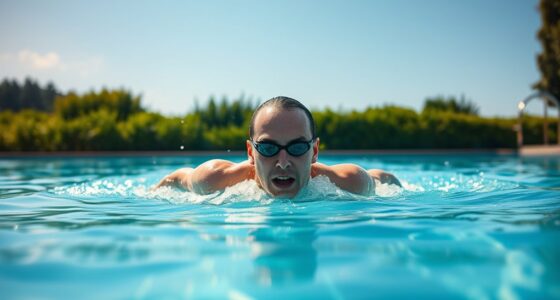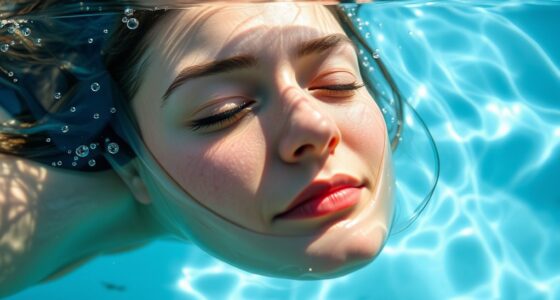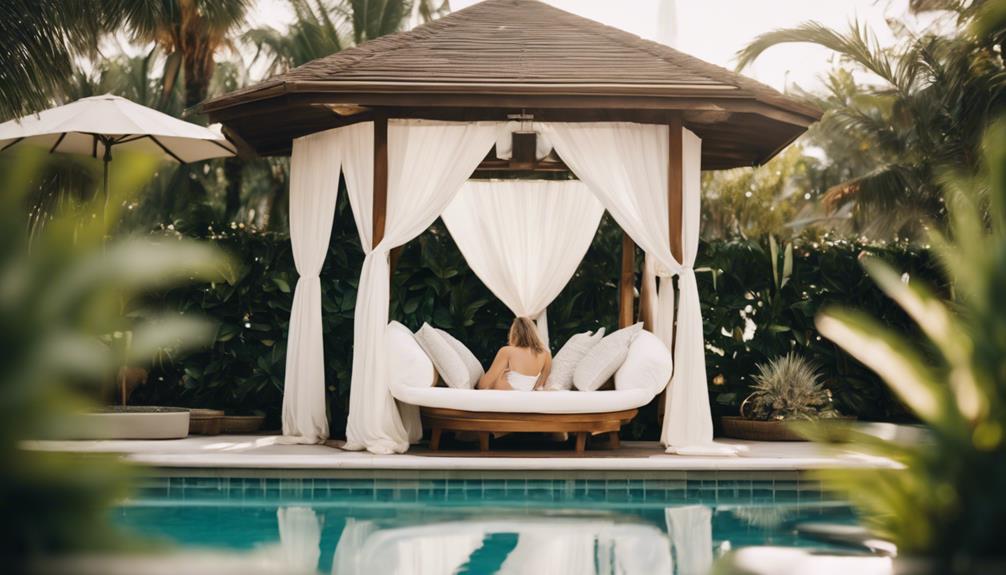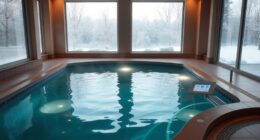Aqua yoga offers gentle water resistance to improve flexibility and promote inner calm. By combining traditional poses with water’s natural support, you can deepen stretches, strengthen muscles, and enhance breath control effortlessly. Water’s softness helps reduce joint impact, making it ideal for relaxation and recovery. Practicing these exercises regularly can boost your mindfulness and overall well-being. Stay with us to explore seven effective pool exercises that can help you find greater flexibility and peace.
Key Takeaways
- Aqua yoga combines water resistance with traditional poses to improve flexibility and promote relaxation.
- Water’s gentle resistance enhances muscle engagement while reducing joint impact, ideal for all levels.
- Breath control and mindful movement in water foster inner peace and stress reduction.
- The buoyancy allows for deeper stretches, increasing flexibility in hips, shoulders, and hamstrings.
- Regular practice enhances body awareness, resilience, and promotes a calming, serene environment.
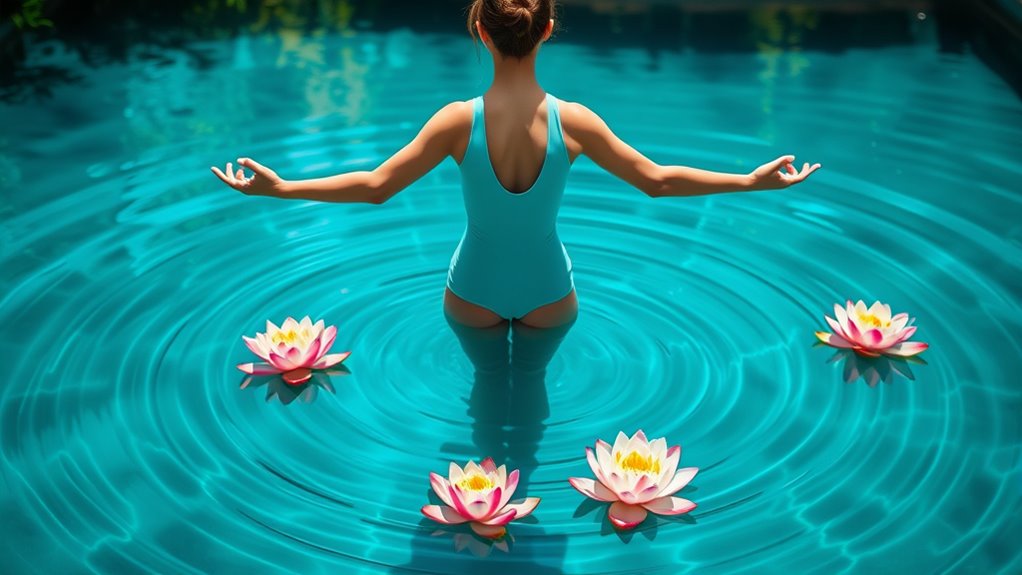
Aqua yoga combines traditional yoga poses with the soothing resistance of water, offering a gentle yet effective way to improve flexibility, strength, and relaxation. As you move through each pose, you’ll quickly notice how water’s natural resistance challenges your muscles, helping you build strength without strain. The resistance isn’t harsh; it’s a soft but persistent force that guides your body into deeper stretches and more controlled movements. This makes aqua yoga particularly suitable if you’re looking to enhance your flexibility or recover from injury, as water minimizes impact and reduces the risk of overstretching.
One of the key aspects of aqua yoga is breath control. Because water naturally slows your movements and creates gentle resistance, you’re encouraged to focus on your breathing. As you flow from pose to pose, you learn to synchronize your breath with your movements, which enhances your overall sense of calm and centeredness. Breath control in water also helps you to stay relaxed and present, making each session a mindfulness practice as well as a physical workout. You’ll find that deep, steady breaths can help you stay buoyant and maintain stability, even when holding challenging poses.
Water encourages mindful breathing, helping you stay calm, balanced, and present during your aqua yoga practice.
In the water, your body’s buoyancy reduces the impact on your joints, allowing you to deepen stretches and hold poses longer than you might on land. This supports increased flexibility, especially in areas like hips, shoulders, and hamstrings. As you work against water resistance while maintaining controlled breathing, your muscles engage more fully, encouraging strength development across your entire body. The resistance also promotes better muscle tone and endurance over time, without feeling exhausting or overwhelming. Additionally, incorporating tuning techniques can further optimize your practice for both performance and relaxation.
Practicing aqua yoga regularly can transform your approach to fitness and relaxation. Water’s natural resistance demands focus and patience, which enhances your body awareness and improves your breath control. As you learn to navigate the gentle yet persistent forces of water, you develop a greater connection between your breath and movement. This synergy helps you cultivate inner peace, reduce stress, and achieve a sense of balance in both body and mind. Whether you’re seeking gentle rehabilitation or a mindful way to stay active, aqua yoga offers a unique combination of physical challenge and calming serenity that can benefit everyone.
Frequently Asked Questions
What Equipment Is Needed for Aqua Yoga?
For aqua yoga, you don’t need much equipment. Your body’s water resistance provides natural resistance, helping strengthen muscles. To enhance your practice, consider using a foam noodle or water weights for buoyancy assistance and added support. These tools make poses easier and more effective, allowing you to focus on flexibility and inner peace. Just make sure your swimsuit is comfortable, and you’re ready to enjoy the calming benefits of water-based yoga.
Can Beginners Safely Practice Aqua Yoga?
You can definitely practice aqua yoga safely as a beginner. Just focus on water safety by staying in shallow areas and listening to your body. Beginners should start with simple modifications to avoid overexertion and guarantee comfort. With proper guidance and awareness, you’ll enjoy the benefits of aqua yoga while minimizing risks. Remember, taking it slow helps build confidence and flexibility, making your experience both safe and enjoyable.
How Often Should I Do Aqua Yoga for Best Results?
You could open the fountain of youth with just the right aqua yoga routine! To see the best results, follow the frequency guidelines of practicing 2-3 times a week. Keep your session duration around 30-45 minutes to maximize benefits without overexertion. Consistency is key, so stick with it, and you’ll notice improved flexibility and inner peace in no time.
Are There Any Health Conditions That Prevent Aqua Yoga?
You might wonder if any health conditions prevent aqua yoga. If you have arthritis concerns or cardiovascular restrictions, it’s vital to consult your doctor first. Aqua yoga’s gentle, low-impact nature can benefit many, but certain conditions may require modifications or caution. Always listen to your body, and work with a qualified instructor to guarantee your safety and comfort during your practice.
What Is the Ideal Water Temperature for Aqua Yoga Sessions?
Imagine stepping into the pool, wondering about the perfect water temperature for your session. The ideal water temperature for aqua yoga is typically between 83°F and 88°F, striking a balance that enhances physical comfort without causing overheating. This range helps you relax, stretch, and breathe easily. Pay attention to your body’s signals; if you feel too warm or too cold, don’t hesitate to adjust the temperature for your best experience.
Conclusion
As you plunge into aqua yoga, think of the pool as your personal sanctuary—a gentle, flowing river guiding you toward greater flexibility and inner peace. With each movement, you’re riding the waves of calm and strength, discovering a harmony that’s as invigorating as a cool breeze. Embrace this practice as your own oasis, where your mind and body can reconnect and flourish beneath the surface. Let the water carry you to a more balanced, peaceful you.

